Shocking cases of child abuse competing with election news for newspaper headlines and primetime television coverage have brought an issue which refuses to go away, to the forefront of national consciousness: open and continuous violation of children’s rights. Summiya Yasmeen investigates
.gif) • March 19. Mumbai police arrested Kishore Chauhan, a 60-year-old businessman for allegedly raping his daughter repeatedly for nine years at the behest of an occultist.
• March 19. Mumbai police arrested Kishore Chauhan, a 60-year-old businessman for allegedly raping his daughter repeatedly for nine years at the behest of an occultist.
• March 26. A Bharatiya Janata Party (BJP) leader was detained for interrogation by the Punjab police for persistent sexual abuse of his college-going daughter for eight years.
• April 6. Forty-year-old Mohammed Salim was arrested by Delhi police for the alleged rape of his four-year-old daughter.
• April 18. Shanno Khan, a class II Delhi municipal school student, died after being beaten and made to stand in the sun for nearly two hours by her class teacher.
These shocking cases of child abuse, which have competed with election news for newspaper headlines and prime time television coverage as the country readies for its 15th general election, have once again brought an issue that refuses to go away, to the forefront of national consciousness: open, continuous and uninterrupted violation of children’s rights. Paradoxically, this proud democracy with the world’s largest child population (450 million) has the worst child neglect and abuse record of any democracy worldwide. It’s shining India’s most painfully obvious development failure.
The grim conditions of deprivation, neglect and lack of legal protection which India’s children have been suffering since independence have repeatedly been highlighted by reports and surveys of international child rights organisations and development agencies, only to be promptly forgotten by the country’s self-enriching politicians and subsidies-grabbing great Indian middle class, who together dominate the public discourse.
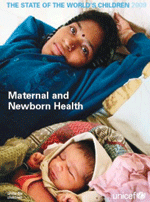 The latest State of the World’s Children 2009 (SWC 2009) of the United Nations Children’s Fund (Unicef), released in New Delhi on January 22, is no different. It estimates that 40 percent of all children (below 18 years of age) in contemporary India suffer chronic poverty and deprivation. According to SWC 2009, of every 100 children born in India, five don’t make it to their first birthday, 46 percent are underweight, 38 percent are moderately to severely stunted and only 50 percent complete primary school.
The latest State of the World’s Children 2009 (SWC 2009) of the United Nations Children’s Fund (Unicef), released in New Delhi on January 22, is no different. It estimates that 40 percent of all children (below 18 years of age) in contemporary India suffer chronic poverty and deprivation. According to SWC 2009, of every 100 children born in India, five don’t make it to their first birthday, 46 percent are underweight, 38 percent are moderately to severely stunted and only 50 percent complete primary school.
A global survey of 189 nations worldwide, SWC 2009 identifies lack of shelter, unsafe drinking water and sanitation, denial of basic health services, food insecurity, lack of access to schools, high infant mortality, malnutrition, child labour and child abuse as indicators of child rights deprivation. In SWC 2009, on the criterion of under-five mortality — “a critical indicator of the well-being of children” — India is ranked 49th and is included in the 50 worst performing countries in the world.
But useful as they are, transnational surveys such as SWC 2009 suffer from lack of access to reliable official data, and offer at best, a bird’s eye view of the extent of child abuse and denial of children’s rights in the Indian subcontinent. Data aggregated from domestic sources indicate that ground realities are much worse. According to a 2007 report of the Union ministry of women and child development, 53 percent of India’s children suffer sexual abuse; 37 million never see the inside of a classroom; 53 percent (105 million) drop out of school before entering class VIII; and an estimated 44-100 million children work in shops, homes, factories and other establishments.
India’s small but growing minority of child rights champions and votaries are unsurprised by these shocking statistics. Because they are well aware that there is almost universal ignorance of the concept of children’s rights in Indian society. Despite the Union government having readily signed international child rights and protection treaties such as the Convention on the Rights of the Child (1990) and the United Nations Millennium Declaration (2000) which set out several Millennium Development Goals including universal primary education by 2015 and reducing under-five mortality by two-thirds, neither the Central nor state govern-ments have made any worthwhile effort to publicise or enforce child rights. The annual outlay for education (Centre plus states) during the past five years has averaged 3.8 percent of GDP (against the promised 6 percent), and 1.25 million government school teachers are absent everyday without fear of consequence.
.gif) Comments Dr. Shekhar Seshadri, professor of child psychiatry and adolescence services at the National Institute of Mental Health and Neuro Sciences (NIMHANS), Bangalore: “Genetically, most adults in Indian society as in other societies, are naturally inclined to love and nurture children. But there is a great divide between intent and transaction. In developing and transitional societies, people tend to suffer violent internal conflict resolution problems which unfortunately impact upon vulnerable and dependent children. In such societies the relationship of adults with children be it as parents, teachers or relatives is structured around instruction, expectation and control, and not around sharing and talking. Out of indifference and ignorance most adults patronise children, seldom acknowledge their rights and fail to recognise their personhood. Moreover Indian society’s strong patriarchal culture inhibits adults from creating a meaningful space for children, and is heavily responsible for the neglect of their rights and opportunities.”
Comments Dr. Shekhar Seshadri, professor of child psychiatry and adolescence services at the National Institute of Mental Health and Neuro Sciences (NIMHANS), Bangalore: “Genetically, most adults in Indian society as in other societies, are naturally inclined to love and nurture children. But there is a great divide between intent and transaction. In developing and transitional societies, people tend to suffer violent internal conflict resolution problems which unfortunately impact upon vulnerable and dependent children. In such societies the relationship of adults with children be it as parents, teachers or relatives is structured around instruction, expectation and control, and not around sharing and talking. Out of indifference and ignorance most adults patronise children, seldom acknowledge their rights and fail to recognise their personhood. Moreover Indian society’s strong patriarchal culture inhibits adults from creating a meaningful space for children, and is heavily responsible for the neglect of their rights and opportunities.”
Indian society’s insensitivity to children’s rights is most tellingly indicated by the obstinate persistence of child labour on a massive scale within the economy. India tolerates the world’s largest child workforce, variously estimated at 44-100 million. Though child labour falls within the purview of the high-sounding Child Labour (Prohibition and Regulation) Act, 1986 which classifies industry sectors as hazardous based on differing physical work environments, it regulates rather than prohibits child labour.
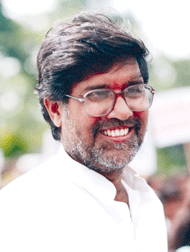 “Inadequate as it is, the Child Labour Act, 1986 has been a dead letter right from the start. Child labour is unchecked across the country, with children working in hotels, shops, factories, and domestic households including those of judges and politicians. There is a political-bureaucratic conspiracy in not booking and punishing violators employing children as cheap labour. Corrupt child welfare officials and government inspectors routinely fudge the ages of children and submit customised reports. To eradicate child labour, officials must be made fully accountable for enforcing laws; the Right to Education Bill to provide free and compulsory education to all children must be immediately enacted; companies and firms employing child labour should be widely shamed, and their products and services boycotted,” says Kailash Satyarthi, promoter-director of the Delhi-based Bachpan Bachao Andolan (‘Save the Childhood Movement’).
“Inadequate as it is, the Child Labour Act, 1986 has been a dead letter right from the start. Child labour is unchecked across the country, with children working in hotels, shops, factories, and domestic households including those of judges and politicians. There is a political-bureaucratic conspiracy in not booking and punishing violators employing children as cheap labour. Corrupt child welfare officials and government inspectors routinely fudge the ages of children and submit customised reports. To eradicate child labour, officials must be made fully accountable for enforcing laws; the Right to Education Bill to provide free and compulsory education to all children must be immediately enacted; companies and firms employing child labour should be widely shamed, and their products and services boycotted,” says Kailash Satyarthi, promoter-director of the Delhi-based Bachpan Bachao Andolan (‘Save the Childhood Movement’).
Yet if India’s child rights organisations and movements are to acquire any momentum, certain widely prevalent myths and misconcep-tions internalised by the country’s influential middle class need to be laid to rest. The most popular of them is that socio-economically disadvantaged (i.e. poor) — especially rural — households are disinclined to send children to school, because they are anxious to put them to work as early as possible. This myth was first busted by the Public Report on Basic Education (PROBE) of the Delhi-based Centre for Development Economics in 1999. PROBE surveyors reported that 98 percent and 89 percent of rural households want their boy and girl children respectively, in school. The survey found that the main causative factor behind two-thirds of the 200 million children who enrol in primary school dropping out before they get to class V, is “that the schooling system is nowhere near ready to provide education of decent quality to every child”.
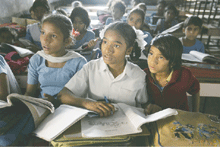 PROBE 1999 was based on a survey conducted in 1996-97 in 200 villages in the BIMARU (Bihar, Madhya Pradesh, Rajasthan and Uttar Pradesh) states, which together host approximately 366 million Indian citizens. Ten years later (2006-07), PROBE surveyors revisited the same villages. They found that while the gross enrolment ratio (GER) had risen sharply from 80 to 95 percent in the six-12 age group, and school infrastructure had improved vastly, “the quality of education remains abysmally low for a vast majority of Indian children”. The PROBE team found that higher GER is not synonymous with regular attendance. Almost everywhere children’s attendance as marked in school musters was much less than GER with actual attendance, as observed by field investigators, even lower. Moreover investigators noted that classroom activity was very low.
PROBE 1999 was based on a survey conducted in 1996-97 in 200 villages in the BIMARU (Bihar, Madhya Pradesh, Rajasthan and Uttar Pradesh) states, which together host approximately 366 million Indian citizens. Ten years later (2006-07), PROBE surveyors revisited the same villages. They found that while the gross enrolment ratio (GER) had risen sharply from 80 to 95 percent in the six-12 age group, and school infrastructure had improved vastly, “the quality of education remains abysmally low for a vast majority of Indian children”. The PROBE team found that higher GER is not synonymous with regular attendance. Almost everywhere children’s attendance as marked in school musters was much less than GER with actual attendance, as observed by field investigators, even lower. Moreover investigators noted that classroom activity was very low.
In a report published in March 2009, members of the PROBE team Jean Dreze, A.K. Shiva Kumar, M. Samson and Anuradha De write: “One reason for low classroom activity is the shortage of teachers. Despite a major increase in the number of teachers appointed, the pupil-teacher ratio in the survey areas has shown little improvement over the years. The proportion of schools with only one teacher appointed has remained much the same — about 12 percent. Aggravating the situation is the fact that teachers often come late and leave early. Even when they are present, they are not necessarily teaching. In half of the sample schools, there was no teaching activity at all when our investigators arrived — in 1996 as well as in 2006. Even in the active classrooms, pupil achievements were very poor. Teaching methods are dominated by mindless rote learning, for example, chanting endless mathematical tables or reciting without comprehension. It is therefore not surprising that children learn little in most schools. For instance, we found that barely half of the children in classes IV and V could do single digit multiplication, or a simple division by 5.”
Indeed of all the rights routinely denied to India’s 199 million children in the six-14 age group, denial of acceptable quality education is the most disabling because it rules out upward mobility. After several years of debating inclusion of the right to education for every child under 14 years as a fundamental right under the Constitution of India, in 2002 Parliament unanimously approved the 86th amendment to the Constitution guaranteeing children between six and 14 years the right to free and compulsory education. Consequently Article 21A promises that “the State shall provide free and compulsory education to all children of the age of six to fourteen years in such manner as the State may by law determine”. However seven years after this historic amendment, which was largely made possible by a sustained public campaign led by the National Alliance for the Fundamental Right to Education (a confederation of over 900 NGOs), the Right to Education Bill required to give effect to Article 21A is yet to be enacted.
Despite assurances that the Bill is a top priority of the outgoing Congress-led UPA government, the Right to Education Bill, 2008, currently in its seventh avatar, was tossed between the finance and law ministries and the Planning Commission for over four years, before being consigned to deep freeze. Now the fate of the Bill, which requires an additional financial commitment of a mere Rs.36,000 crore (less than 1 percent of GDP), hangs in the balance and will be decided — if at all — only after a new government is sworn into office in New Delhi this summer.
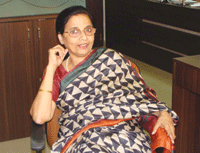 “Until formal enactment of the Right to Education Bill, access to free and compulsory education will remain a partial reality for the children of this country. However though GER has improved, the issue of quality of education in government schools needs to be addressed. According to our Annual Status of Education Report 2008, 25 percent of children studying in class I cannot read basic alphabets or numerals. That’s why the number of children dropping out of primary school is as high as 38 percent. The initiative to universalise primary education will succeed only if there is a focus on improving teacher quality and learning outcomes. Otherwise it’s a wasted effort,” says Farida Lambay, the Mumbai-based co-founder of Pratham, which provides 21 million children countrywide supplementary reading and basic maths education.
“Until formal enactment of the Right to Education Bill, access to free and compulsory education will remain a partial reality for the children of this country. However though GER has improved, the issue of quality of education in government schools needs to be addressed. According to our Annual Status of Education Report 2008, 25 percent of children studying in class I cannot read basic alphabets or numerals. That’s why the number of children dropping out of primary school is as high as 38 percent. The initiative to universalise primary education will succeed only if there is a focus on improving teacher quality and learning outcomes. Otherwise it’s a wasted effort,” says Farida Lambay, the Mumbai-based co-founder of Pratham, which provides 21 million children countrywide supplementary reading and basic maths education.
Denial of qualitatively or infrastructurally acceptable education to the overwhelming majority of the 200 million children who enrol in 1.19 million government primaries at the start of every academic year, and widespread tolerance of child labour are not the only proofs of Indian society’s ignorance and/or apathy of child rights. To this body of evidence add the growing population of vagrant street children in urban India.
“During the past two decades, rapid urbanisation has led to a massive increase in numbers of street children. Most of them leave home to escape unhappy family environments, while some are deserted by their parents. Most of them work 10-12 hour days as rag pickers, hawkers, shoeshine boys, in shops and establishments and as domestics for pitiful wages. Growing up on the mean streets of India, these children are subject to constant harassment and eviction by the municipal authorities and corrupt policemen. They usually become drug addicts given to peddling, smoking, gambling and drinking, apart from suffering persistent physical and sexual abuse. This is very dangerous for the future of India,” says Khushwant Singh, director of the Ankur Yuva Chetna Kendra, a 25-year-old Lucknow-based NGO which works with street children, in addition to running education projects for 2,000 school dropouts.
Astonishingly there seems little awareness within the Central, state and local governments or within Indian society that India is a signatory to the Convention on the Rights of the Child (CRC), adopted by the United Nations General Assembly on November 20, 1989. India ratified the convention in 1993 following intense pressure from NGOs and other child rights organisations in India and abroad. An amalgamation of several legal systems and cultural traditions, CRC is a universally agreed set of non-negotiable standards and obligations all signatory nations must respect and discharge. It spells out the basic human rights of children which governments have to uphold: the right to survival; full development; protection from harmful influences, abuse and exploitation; and full participation in family, cultural and social life. The convention also spells out minimum standards in healthcare, education, legal, civil and social services.
Successive governments in New Delhi and state capitals pay CRC and the Millennium Declaration little more than lip service, even as the great majority at the bottom of India’s iniquitous socio-economic pyramid is too ignorant and poor to speak up for their children. NGO workers, child rights activists and academics believe that the best option is to arouse public opinion in favour of a better deal for India’s neglected children. True, India’s 450 million children (below 18 years of age) don’t vote on E-Day, but parents constitute the majority of the electorate. Advocates reckon that by spreading awareness within the parents’ community about the rights of children to shelter, nutrition, healthcare and education, pressure can be exerted on governments and politicians to imple-ment the provisions of CRC, MDGs etc.
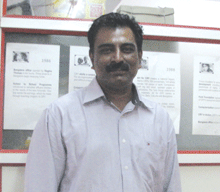 “In the May 2004 general election, we prepared and presented a detailed child rights charter to all major political parties including the Congress, BJP and the Left. Though they pledged support to the charter, none of them included any of its provisions in their election manifestos. Therefore for the 2009 general election we have changed our strategy and have taken the child rights manifesto directly to the people. Since politicians listen only to public opinion, in our awareness campaign we are especially targeting under-privileged communities, because poor children are twice-removed from the field of public debate and democratic politics. Not only do they lack voice within the family, their parents themselves have little voice in the system due to economic, social and political disempowerment. By helping them demand justice for their children from political parties who want their votes, we hope to mobilise mass public opinion in favour of enforcement of children’s rights,” says John Roberts, the Bangalore-based general manager, development support of Child Rights and You (CRY), a funding agency which supports 190 NGOs and partners to implement education/child-centric projects in 20,000 villages countrywide.
“In the May 2004 general election, we prepared and presented a detailed child rights charter to all major political parties including the Congress, BJP and the Left. Though they pledged support to the charter, none of them included any of its provisions in their election manifestos. Therefore for the 2009 general election we have changed our strategy and have taken the child rights manifesto directly to the people. Since politicians listen only to public opinion, in our awareness campaign we are especially targeting under-privileged communities, because poor children are twice-removed from the field of public debate and democratic politics. Not only do they lack voice within the family, their parents themselves have little voice in the system due to economic, social and political disempowerment. By helping them demand justice for their children from political parties who want their votes, we hope to mobilise mass public opinion in favour of enforcement of children’s rights,” says John Roberts, the Bangalore-based general manager, development support of Child Rights and You (CRY), a funding agency which supports 190 NGOs and partners to implement education/child-centric projects in 20,000 villages countrywide.
Appeals to the public, rather than to insensitive and myopic politicians, is also the new strategy of the Delhi-based Bachpan Bachao Andolan (BBA) and National Coalition for Education (NCE), two child rights NGOs which have made common cause to launch an ‘Elect those who work for Child Rights’ campaign. Active in more than 250 parliamentary constituencies, they have brought public pressure to bear on more than 800 Lok Sabha candidates who have signed pledges promising to raise the issue of child rights in Parliament, if elected. After the election, BBA will release a list of candidate profiles and their child friendliness.
Meanwhile, the best official responses to pervasive child healthcare and education deprivation which are a blot on Indian democracy, are the Central government’s Integrated Child Development Services (ICDS) and Sarva Shiksha Abhiyan (Education for All) programmes. The ICDS programme, administered by the Union ministry for women and child development (WCD), was launched in 1975 in 33 community blocks. According to a ministry spokes-person, this programme — which provides healthcare to pre-school children, pregnant and nursing women through a package of services including supplementary nutrition, pre-school education, immunisation, health check-ups, referral services and health education — now covers “56.21 million beneficiaries, comprising 46.71 million infants (0-6 years) and 9.5 million pregnant and lactating mothers through a network of about 74.8 million anganwadi (child care) centres”.
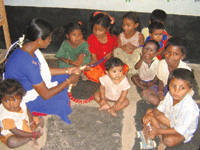 The fact that three decades after ICDS was launched, the programme covers merely 46 million of India’s estimated 118 million infants and less than a third of the country’s chronically anaemic, pregnant and lactating women, doesn’t faze officials in the WCD ministry. “ICDS is one of the world’s largest programmes for early childhood development with an annual budget of Rs.8,000 crore. In a programme of this magnitude, shortfalls in implementation are inevitable. But we are largely satisfied with its coverage and the positive impact it has made on the lives of children and mothers. With the Central government having reaffirmed its commitment to the universalisation of this scheme in December last year, ICDS will get a big boost. With the honorarium of anganwadi workers having been increased recently, training norms for child workers have been revised leading to significant nutrition improvement in children covered. Those who criticise ICDS don’t appreciate the complexities of administering such a large-scale project. They must realise that implementation on such a large scale is not easy,” says Dr. A.K. Gopal, the Delhi-based director of the National Institute of Public Cooperation and Child Development of the ministry of WCD.
The fact that three decades after ICDS was launched, the programme covers merely 46 million of India’s estimated 118 million infants and less than a third of the country’s chronically anaemic, pregnant and lactating women, doesn’t faze officials in the WCD ministry. “ICDS is one of the world’s largest programmes for early childhood development with an annual budget of Rs.8,000 crore. In a programme of this magnitude, shortfalls in implementation are inevitable. But we are largely satisfied with its coverage and the positive impact it has made on the lives of children and mothers. With the Central government having reaffirmed its commitment to the universalisation of this scheme in December last year, ICDS will get a big boost. With the honorarium of anganwadi workers having been increased recently, training norms for child workers have been revised leading to significant nutrition improvement in children covered. Those who criticise ICDS don’t appreciate the complexities of administering such a large-scale project. They must realise that implementation on such a large scale is not easy,” says Dr. A.K. Gopal, the Delhi-based director of the National Institute of Public Cooperation and Child Development of the ministry of WCD.
Likewise, according to Union HRD ministry spokespersons, the SSA primary education universalisation programme, initiated by the BJP-led NDA government in 2001 to comply with the Millennium Declaration signed by 189 governments in New York in the year 2000, covers 192 million children (six-14 years) in 1.1 million habitations countrywide. But while the GER (gross enrolment ratio) record of SSA — 95 percent — is impressive, a number of independent learning outcomes surveys indicate that the quality of education delivered in the country’s 1.19 million government primaries is stagnant.
According to the Annual Status of Education Report (ASER) 2008, which assesses learning outcomes in rural government primaries in 587 of India’s 630 administrative districts, 42 percent of children in class V are unable to exhibit the learning and comprehension capability they should have attained in class II. Published by the well-known education NGO Pratham, ASER is a much acclaimed independent audit of government primaries conducted with the help of 20,000 volunteers who fan out countrywide every year.
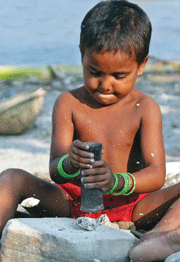 Although some economic commentators (such as Swaminathan Aiyar of the Economic Times), citing data which indicates that communist China has attained 90 percent literacy (cf. India’s 64 percent) despite expending only 2.5 percent of GDP for education (cf. India’s 4 percent), are against higher budgetary outlays for education and call for greater expenditure efficiency, majority opinion within the intelligentsia is that India’s shameful child neglect and deprivation statistics are attributable to the establishment’s reluctance to raise education and health outlays.
Although some economic commentators (such as Swaminathan Aiyar of the Economic Times), citing data which indicates that communist China has attained 90 percent literacy (cf. India’s 64 percent) despite expending only 2.5 percent of GDP for education (cf. India’s 4 percent), are against higher budgetary outlays for education and call for greater expenditure efficiency, majority opinion within the intelligentsia is that India’s shameful child neglect and deprivation statistics are attributable to the establishment’s reluctance to raise education and health outlays.
Way back in 1966, the Kothari Commission had strongly recommended an annual outlay of 6 percent of GDP on education. But for the past 60 years since independence, despite India hosting the world’s largest child population, government outlays for education and health have not exceeded 4 percent and 1.5 percent of GDP respectively. In this connection, it’s pertinent to note that ever since EducationWorld was promoted in 1999, it has advocated re-ordering of government spending priorities to facilitate larger outlays for primary education. On several occasions, we have suggested additional resource mobilisation innovations to free up resources for investment in public primaries. For instance last April (2008), following presentation of the Union budget 2008-09 which typically made a grudging provision for primary education, EducationWorld presented a detailed blueprint for raising an additional Rs.100,000 crore to equip every primary school countrywide with a laboratory, library and toilet block to make them more attractive to children (see cover story EW April 2008).
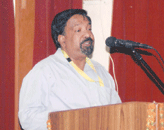 “India’s overall performance in providing basic amenities to children is abysmal, because there’s minimal awareness even in government that food, clothing, shelter, education, health and protection is the right of every child. All political parties are to equally blame for neglecting to respect these fundamental rights of children, despite India having voluntarily signed the United Nations Convention on the Rights of the Child and the Millennium Development Declaration. Now we need to adopt a radically different approach by making child rights the pre-requisite of national prosperity. The Central and state governments have to redraw their spending priorities in favour of primary education and child healthcare, and the middle class needs to speak up not only for their children, but for all children. Only the unrelenting pressure of public opinion will force governments to redraw national priorities in favour of the nation’s vulnerable children,” says Augustine Veliath, a Lucknow-based communications specialist working with Unicef, India.
“India’s overall performance in providing basic amenities to children is abysmal, because there’s minimal awareness even in government that food, clothing, shelter, education, health and protection is the right of every child. All political parties are to equally blame for neglecting to respect these fundamental rights of children, despite India having voluntarily signed the United Nations Convention on the Rights of the Child and the Millennium Development Declaration. Now we need to adopt a radically different approach by making child rights the pre-requisite of national prosperity. The Central and state governments have to redraw their spending priorities in favour of primary education and child healthcare, and the middle class needs to speak up not only for their children, but for all children. Only the unrelenting pressure of public opinion will force governments to redraw national priorities in favour of the nation’s vulnerable children,” says Augustine Veliath, a Lucknow-based communications specialist working with Unicef, India.
Even as post-independent India’s hidebound politicians and bureaucrats continue to ignore the development models of countries around the world which accord top priority to education and health, 21st century India is increasingly acquiring the dubious reputation of a criminally neglectful child- averse society. Quite clearly there is something fundamentally wrong — indeed rotten — about the culture and character of a nation which is apathetic to the cries and all-too-patent suffering of its most vulnerable citizens.
With Autar Nehru (Delhi); Vidya Pandit (Lucknow) & Harshikaa Udasi (Mumbai)